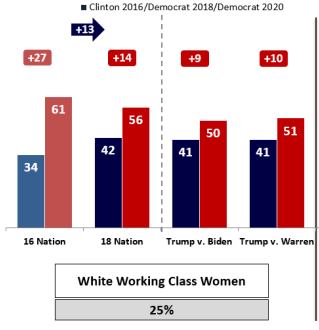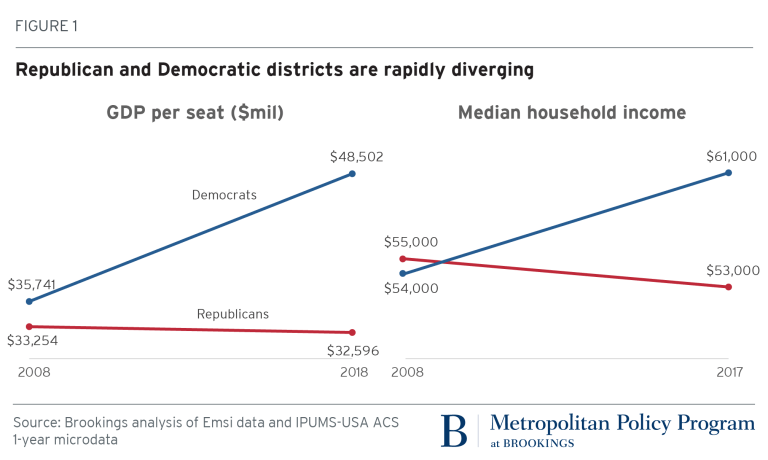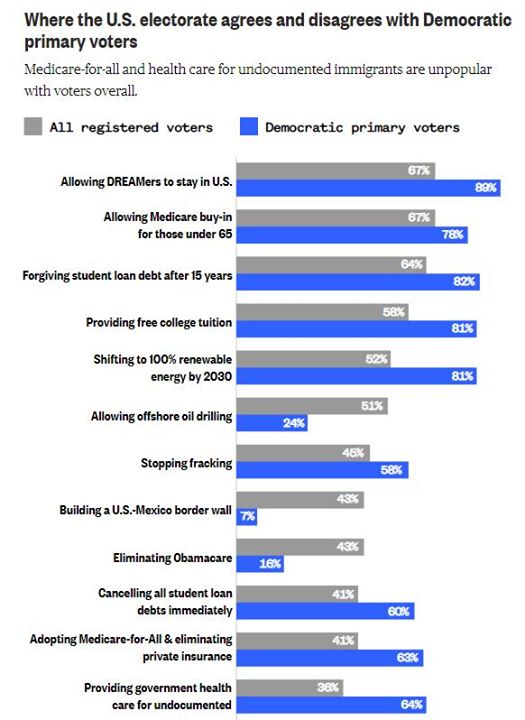In his NYT column “Will Trump Ever Leave the White House,” Thomas B. Edsall addresses a question of growing concern, given the President’s penchant for increasingly unhinged rants. Edsall sides more with those who see trouble ahead. But he does quote the more optimistic Brookings scholar William Frey: “There is no doubt that Trump continues to fan the flames of racial anxiety for his perceived benefit. He tries to paint an America that has shifted from the white dominated 1950s when immigration was low and blacks were highly segregated…This is not the America of today and really only applies to a swath of the population ages 55 and above and in whiter parts of the country whose populations are increasingly diminishing…Now Trump is less popular in general and Republicans have done less well in the 2018 midterms including among whites, especially white women, and in nonurban areas…Yes, some people are afraid of a nonwhite takeover for America but they are a small and dwindling piece of the American electorate. Highlighting race as a primary campaign message will not work for Trump again.” A sober assessment, especially considering that Trump doesn’t have the backing of the modern, multi-racial military or the broad media control needed for such a coup. Nor would American business leaders, who are already skeptical about his disruption of international trade, welcome the domestic chaos it would bring.
Washington Post columnist E. J. Dionne, Jr. wonders “Will impeachment finally organize the Democrats?,” and observes: “Normally, Democrats wear their diversity as a badge of honor, even as they feud and scuffle. But with House Democrats in the heat of an impeachment inquiry into President Trump, the habits of political lifetimes collide with the imperatives of discipline and focus…And Democrats being Democrats, they are even arguing about who deserves credit for the decision to open an impeachment inquiry. When CNN posted a feature about how moderates moved the House to act, champions of the party’s outspoken progressives, who had long endorsed this step, asked why they did not get more credit for being there all along…Democrats are determined to challenge Trump every time he claims that impeachment is getting in the way of action on prescription drug prices, guns and other issues that helped elect the new moderates. Pelosi went out of her way to open the news conference by focusing on these questions, not impeachment. She said that if the president used the House’s investigation as an excuse for governing sloth, “the ball is in his court.”…Because things have suddenly become so serious, Democrats just might learn to behave differently. “We have this fragile majority and right now we are all that stands between these attacks by the president and his enablers across the aisle on the fundamentals of our democracy,” [vice chair of the House Democratic caucus Katherine] Clark said. If this responsibility doesn’t concentrate the mind of a party that adores brawling, nothing will.”
From Kyle Kondik’s “The Senate: Ratings Changes and the Shadow of Impeachment” at Sabato’s Crystal Ball: “We would be lying if we said we had a great sense as to how the Democrats’ drive to impeach Trump will impact the elections next year. There are just too many variables and moving pieces to feel strongly about it. But the potential for the battle to harden partisan attitudes may have down-ballot effects for some members of Congress, as noted above…But don’t be surprised if, for all the noise, the impeachment inquiry — and even a successful House vote for impeachment and subsequent Senate trial — does not lead to sharp changes in public attitudes. It is true from limited polling that, at the very least, Democrats are coalescing around impeachment after the revelation of the now-famous telephone readout between Trump and the Ukrainian president. What seems to be happening is that Democrats are taking their cues from party leadership, which has resisted calling for impeachment until now, and increasing their own support for impeachment as a result. There has been some movement in favor of impeachment among independents and Republicans, although one would have to cherry-pick data to argue that overall support for impeaching and removing the president is significantly more than mixed…Meanwhile, the president’s approval rating — as it seems to do — has remained largely fixed where it’s been, in the low-to-mid 40s, with disapproval over 50%. Could the Ukraine bombshell and subsequent discoveries from the impeachment process cause it to dip over time? Sure…But after years of observing the president’s durability in polls, thanks in large part to strong GOP support, it’s safer to expect continuity as opposed to change in the president’s standing.” Kondik notes, “There are two Senate ratings changes this week, one benefiting each side. The most vulnerable senator, Sen. Doug Jones (D-AL), moves from Toss-up to Leans Republican, while Sen. Thom Tillis (R-NC) moves from Leans Republican to Toss-up.”
Ronald Brownstein explains why “The Risks of Impeachment Are Overblown” at The Atlantic: “For months, the biggest hurdle for Democrats pushing the House to open impeachment proceedings against Donald Trump was the party leadership’s concern that such a process would politically endanger the members at the far edge of their majority, especially the 31 representing districts that voted for the president in 2016…But there’s considerable evidence—both in contemporary polling and the experience of former President Bill Clinton’s impeachment—that impeaching Trump might not be nearly as risky as it’s been portrayed for them…Despite the cascade of new revelations damaging to Trump, some Democratic strategists focused on holding the House still privately worry that impeachment could endanger too many of the members from districts that divide closely between the parties or lean Republican. That’s been the dominant perspective at the Democratic Congressional Campaign Committee, which is chaired by Representative Cheri Bustos, who herself represents an Illinois district Trump won in 2016. Yet other party strategists now see a pathway to expanding support for impeachment, which a majority of Americans have consistently opposed in polls, or at least neutralizing any recoil against it.”
Brownstein continues, ““If voters see this as being about significant abuses of power and serious attempts to undermine the rule of law, then I don’t worry particularly about a backlash against Democrats who vote for impeachment,” says the longtime Democratic pollster Geoff Garin. “If it is seen purely as a partisan exercise, the answer may be different. But I have a good level of confidence that it will not be seen that way, that the moderates in the Trump districts who eventually support impeachment will be seen as having done so for serious and sober reasons.” Noting that “Clinton’s job approval rating about 20 percentage points higher than Trump’s is today,” Brownstein adds, “The other big difference is that, unlike Clinton, Trump will be on the ballot in 2020 (absent the unlikely event of enough Senate Republicans voting to remove him from office if the House does eventually impeach him.) “There is no escaping Trump,” says Sarah Binder, a senior fellow in governance studies at Brookings. “He is the 800-pound elephant … There is no escaping his relevance to this election. It just seems that might be quite different than what happened in 2000 once you had Clinton departing from the scene.”
Further, says Brownstein, “Other analysts point to Trump’s uncertain position even in the Democratic-held districts that he carried. Trump was hardly a colossus in those 31 seats in 2016: He exceeded 51 percent of the vote in only six of them, and reached 50 or 51 percent in just seven more. He beat Hillary Clinton while drawing less than half of the total vote in the other 18 of those seats…That distinction hasn’t escaped the Democratic members in those districts: By the time Pelosi made her announcement on Tuesday afternoon, 10 of the 18 Democrats from districts where Trump won with less than half of the vote had endorsed an impeachment inquiry. By comparison, at that point, only four of the members from the 13 Democratic-held seats where Trump did reach a majority had joined the call for impeachment proceedings, according to the tracker maintained by Politico…After starting in such an equivocal position in many of these districts, Trump’s position appears to have eroded since 2016. A recent round of polls conducted for a consortium of Democratic groups placed Trump’s approval rating below 45 percent in several of the Democratic districts he won, and above 50 percent in only one: the Oklahoma City seat of Representative Kendra Horn, according to figures provided to me.” Even better, “The upcoming debate could create risks for Republicans too, in the states and House districts trending away from Trump, such as the concentration of suburban seats in Texas that Democrats are targeting. If impeachment reaches the Senate, Republican incumbents such as Susan Collins of Maine, Martha McSally of Arizona, and Cory Gardner of Colorado may be unlikely to vote to convict the president—which will bind them to him more tightly in states where his position is equivocal at best.”
At FiveThirtyEight, Perry Bacon, Jr. explains why “Why Black Voters Prefer Establishment Candidates Over Liberal Alternatives,” and notes, “Black voters effectively delivered Hillary Clinton the Democratic presidential nomination in 2016. She and Sen. Bernie Sanders ran about evenly among white voters, but black voters overwhelmingly backed Clinton. So did the Democratic establishment…That team-up — black voters and the more establishment candidate — is not unusual…We don’t have detailed exit polls of Democratic primaries for most other offices, but according to pre-election polls and precinct results in a number of high-profile House and gubernatorial primaries since 2016, black voters have tended to back the candidate from the party’s establishment wing over a more liberal alternative. And at least for now, we’re seeing the same pattern in the 2020 Democratic presidential race: Sens. Elizabeth Warren and Sanders are fairly competitive with Joe Biden among white Democrats, but trail the former vice president substantially among black Democrats…Why, though? After all, African Americans have dramatically less incomeand wealth than white Americans, so messages of “big, structural change” (Warren) or a “political revolution” (Sanders) should, in theory, be particularly appealing. Because a higher percentage of black Americans than white Americans don’t have health insurance, a program like Medicare for All, for example, would disproportionately benefit black people.”
Bacon elaborates, “So what gives? I’m going to offer some potential answers to that question, but let’s first get a couple caveats and complications out of the way…First, it’s hard to come up with a definitive explanation for the establishment-black voter alliance because the “establishment” is a fuzzy concept. Exactly which candidate is a center-left, establishment Democrat and which is anti-establishment or “the liberal alternative” is all a bit subjective…Second — and this is important — black Democrats are not a monolith and are divided in some of the same ways white Democrats are divided. Young black voters are less supportive of Biden (and were less supportive of Clinton in 2016) compared to older black voters. Similarly, black voters without college degrees are more supportive of Biden than those with degrees…That said, blacks of all demographics are more supportive of Biden than their white counterparts, according to Morning Consult polling data. Young black voters are more supportive of Biden (and were more supportive of Clinton) than young white voters. Older black voters were more supportive of Clinton than older white ones in 2016 and now are strongly behind Biden. Black college graduates are more supportive of Biden than white college graduates. Nuances aside, the weakness of the liberal wing of the Democratic Party with black voters is a well-known phenomenon that people in the Warren and Sanders camps and anti-establishment liberal activist groups are openly grappling with.”
Bacon provides five other factors, in order of importance: “1. Establishment candidates typically have existing ties to the black community; 2. Black voters are pragmatic; 3. Black leaders are part of the establishment and support its candidates; 4. The liberal wing of the Democratic Party appeals to the well-educated more than other groups, and the vast majority of black Democrats don’t have college degrees;5. The left wing isn’t running enough black candidates. In addition, Bacon writes, “We could come up with some other explanations, but I think those are the strongest. And this analysis points to a blueprint for the left wing of the Democratic Party if it wants to win more black votes:
- Align with black candidates or non-black candidates with strong ties to black voters and leaders
- Aggressively court black leaders for endorsements
- Directly address black voters’ concerns that more liberal candidates have a greater chance of losing races to Republicans
- And target black voters under 45 and those with college degrees, who might be less inclined to vote for establishment candidates.
Bacon concludes, “So could that approach work for Sanders and Warren against Biden? Maybe. You could imagine Warren in particular getting endorsements from younger liberal black figures like Gillum or Pressley (particularly if Warren wins one of the early primary states and Harris finishes far behind and is no longer viable). And maybe those endorsements and Warren’s campaigning then lead her to become the candidate of black voters under 45 and those with college degrees, even if Biden still gets most votes from older and less educated black voters…Remember, Sanders or Warren don’t necessarily have to win the black vote to become the Democratic nominee — they just can’t lose it by 60 percentage points, as Sanders did in 2016. (Biden is getting between 40 and 50 percent of the black vote in most polls now, so nowhere near Clinton 2016 levels. But Clinton was in a two-candidate field, and I would expect Biden’s support among black voters to go up as this gigantic field shrinks.)…But even if Sanders or Warren gets more support among black voters in 2020 than the Vermont senator did in 2016, I tend to think Biden will remain fairly popular with black voters overall — because of his ties to Obama and other black leaders and the perception that he can defeat Trump.”











